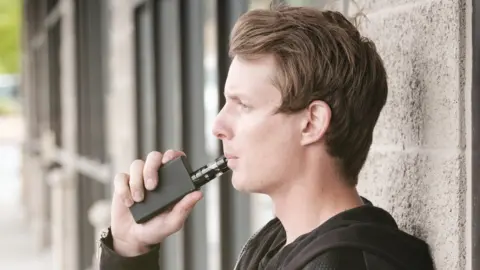Vaping: How do you quit e-cigarettes?
 Getty Images
Getty ImagesQuitting ain't easy. But vaping's helped millions of people to ditch traditional cigarettes.
It's widely considered less harmful than smoking tobacco - and the UK government endorses vapes as a quitting aid.
But what do you do when you want to take the next step and quit completely?
Why is vaping so addictive?
The main reason vaping gets you hooked is nicotine - the same ingredient that makes smokers crave cigarettes.
It's thought to be pretty harmless on its own, but is powerfully addictive. That's why vaping isn't recommended for non-smokers.
Nicotine creates new receptors in the brain when it enters the body, and you quickly come to associate it with feeling good.
So when you stop getting it you'll feel cravings. These tend to be worse in the first three to four days after your last dose.
According to the NHS, other withdrawal symptoms, like bad moods, are likely in the early stages of quitting.
How long does it take to quit vaping?
There's no firm answer to this - it varies for each person - but there are some things we do know.
It's technically possible to go "cold turkey" and suddenly stop vaping. But most people find this very difficult.
Experts, such as the National Centre for Smoking Cessation and Training (NCSCT), generally recommend some sort of gradual approach.
One tip for vapers is to reduce the nicotine strength of their e-liquid in two to four-week stages, working down to 0% solutions.
This can be trickier with disposable vapes, which tend to come in higher strengths.
But zero-nicotine versions are available, and the NCSCT says using one alongside your regular vape can help.
Failing that, a temporary switch to a tank-style vape, giving you access to different e-liquids, might be better.
 Getty Images
Getty ImagesOther reduction strategies include:
- Extending the time between vapes
- Taking shorter puffs (especially if you use a disposable)
- Setting rules for yourself, like only vaping outside the home
Another option is Nicotine Replacement Therapy (NRT) - patches, gum and sprays used instead of a vape.
Nicotine pouches that go between the gum and lip are starting to appear on some shop shelves but these aren't currently recommended by the NHS.
Pull the triggers
Like smoking, if you've been vaping a long time you're likely to have formed habits around it.
Certain situations or times of day - triggers - will have got you used to reaching for your vape.
This can be hard to snap out of, so it can help to figure out what they are.
It's also a good idea to try and fill this time with something else to distract you, like exercise.
If you are a former smoker, the NCSCT says it's worth keeping a vape on hand for emergencies.
Because, if you do relapse, it's better than reaching for a cigarette.


